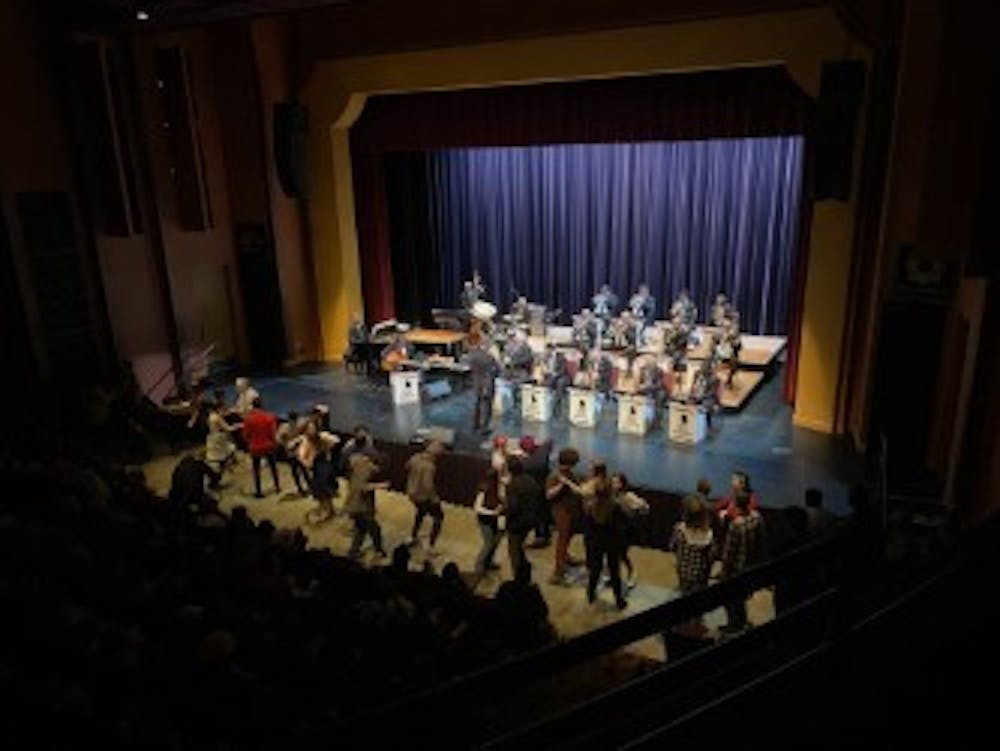The legendary Count Basie Orchestra came to the Buskirk-Chumley Theater Feb. 9, bringing with them some of the best big band music ever to hit the stage. Solidly in the top two big bands of all time, the Basie Orchestra energized and elated the Buskirk-Chumley as it has been doing since 1935.
Jazz Studies department chair Tom Walsh and Jacobs School of Music Dean Abra K. Bush emerged before the show to address the audience. Bush said the show was organized on very short notice, having first been mentioned only two weeks prior to the show date.
They introduced the band, who opened with a very fast and energetic number to get the crowd’s attention. It seemed to end as quickly as it began, with a ripping tenor saxophone solo by Doug Miller making a bold statement during the song’s middle section.
Related: [COLUMN: John Mellencamp performs for sold-out crowd]
They moved on to “Moten Swing,” a mid-tempo classic of the Basie band. This ensemble has always been known for its heavy swing, and this performance was certainly no exception. The band played on the back of the beat to an almost disorienting degree but always managed to stay together and in time. Tunes like “Moten Swing” showed that the pervasive laid-back style of the Basie Orchestra is here to stay — and is arguably better than ever.
Each section of the band was perfectly in sync with itself, and each played off the energy of the other three magnificently, forming an interlocked, weaving texture. Their dynamic control was second to none. Basie’s compositions are known for jumping between incredibly sparse and quiet and shockingly loud and boisterous. This ensemble handled these shifts with unbelievable grace, providing an experience that never stagnated.
The theater was packed, with almost every seat filled by students and community members. The crowd was energetic and passionate, feeding off the immense energy of the band and returning it in spades.
At one point, the group’s director, Scotty Barnhart, began counting off a tune that left the other musicians scrambling for their music. As it turned out, Barnhart had called the wrong tune, but the band went ahead and played it anyway, showing their versatility and easygoing nature.
As the show went on, many of the seats on the floor gradually emptied as people got up to occupy the small dance floor in front of the stage. The dancers included those experienced in jazz-style ballroom dancing and those who just wanted to move to the music, increasing the intensity of the room’s energy.
Related: [The art of making music for the sake of it: an interview with Jeff Day]
When they reached “Honeysuckle Rose,” the band brought out its vocalist, Carmen Bradford. Immediately, the band’s sound changed completely, supporting Bradford while remaining tight and flashy. Bradford’s vocals were charismatic and bold, heavenly smooth with a healthy dose of bluesiness.
No matter what the Count Basie Orchestra played, it had the audience enraptured. They held on to every note with bated breath, due in no small part to the ensemble’s attitude. Each tune was packed to the brim with joy and even humor, with players making occasional references to recognizable tunes like “Rhapsody in Blue.”
At the set’s end, Barnhart implored the people of Bloomington to have the Basie Orchestra back and was met with uproarious applause. Considering the success of this show, it’d be surprising – and frankly, tragic – if the ensemble didn’t make a return in the years to come. When they do, Bloomington will no doubt welcome them with open arms.




